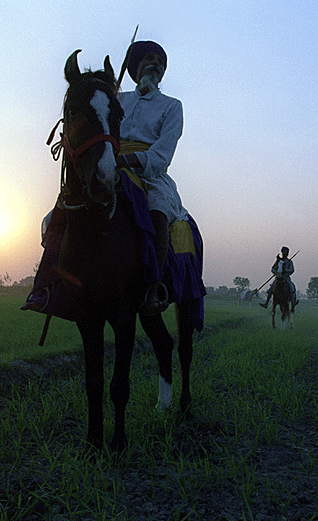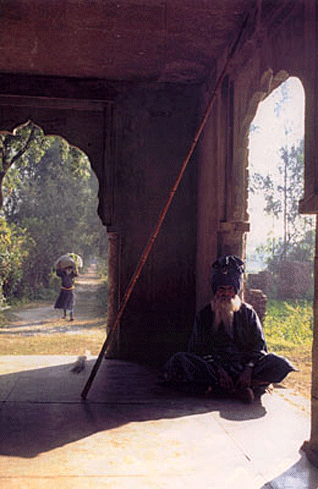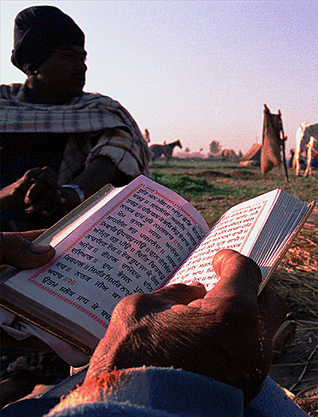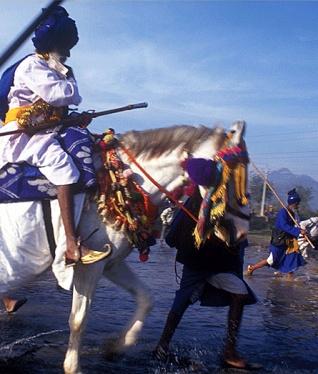Columnists
Recycling with the Nihangs
by GURU KAUR
A throw-away line completely opened my eyes to what was actually going on around me. "Nick, where's the bin?", I asked, as I wandered around the room, looking for somewhere into which to deposit a plastic bag and its contents.
"There isn't one here", he nonchalantly replied, "nor is there one anywhere in the camp".
We were in Punjab in the lead-up to the Khalsa Tercentenary of 1999, just months before mobile phones moved in to herald the new millennium. Now, each time we return, it is harder to forget Western civilization and the 21st century. The cacophony of tacky ringtones doesn't blend so easily with the stillness of prayer or the beat of spiritual music.
Nick had actually been living and photographing at this camp for a while by the time I went to stay there with him from the small village where I was then living, at the other end of Punjab. I was already used to all the rural sanitary arrangements, and had even grown to love the sensuousness of having a bath with a bucket of freezing water in an open outdoor closet and all the other things which wake us up out of our Western comfort zone.
The lack of privacy, the lack of personal space, the lack of respect that what is mine is mine and is not for general consumption - each had changed my outlook on life forever. Now, though, I was confronted with a different issue: where do I put my rubbish?
Harian Belan in Hoshiarpur, Punjab, is a beautiful haven set in the rich lush greenery of Northern India. It is the home to a community of Nihang Singhs, spiritual warriors whose way of life has not changed from three hundred years ago, when they were brought together by Guru Gobind Singh as his army. It is a very spiritual place and the sound of people reading from the Sikh scripture, called the Guru Granth Sahib, echoed throughout, enhanced by birdsong and the ubiquitous chirping of grasshoppers.
The tinny loudspeakers and the jeeps the Nihangs travelled around in when they weren't on horseback were the only way of knowing we weren't back in the 17th century. The bag in my hand became a statement of modernity in deep conflict with the eternal balance of nature and man.
We had many hours to idle away and I began to observe how the camp worked and the community cooperated together. All food is cooked in camp in the communal kitchens. This feeds the members of the camp and any who come to visit or are just passing through.
A deep-seated part of the Sikh way of life is to feed people. Chapattis the size of dinner plates, pitted, bubbled and occasionally burnt, along with lentils and very spicy vegetables, are cooked on fires which are constantly being stoked with the dried leaf waste from the fields.
The leftover food (because nothing is ever reheated) is fed to their horses and the local dogs. The water is from the well. The ash from the fire is piled up just outside the eating area and used as washing-up liquid to clean the stainless steel plates and cups.
Sewage is turned into compost which is used on Harian Belan's extensive fields, which grew all the food necessary to support the community. Any things bought from the market, such as spices, come in paper bags, which are added to the kitchen fires. In the cold winter months, we all huddled up around the fire which kept the kettle boiling all day.
How warm those metal cups are when filled with chai! I don't really like tea and so would be given buffalo milk straight from the udder instead, which was just as warm. The buffalo were fed on all the vegetable peels. In all of this, there was nowhere for plastic to go.
While we were there, a mela (fair) took place. No big deal, only ten thousand people were expected. In the days running up to it, all our duties were enhanced. Everyone in the camp, including us, was given seva (literally, "selfless service") to perform.
Nick spent two-and-a-half hours each morning and night cross-legged on the floor, making balls out of the chapatti dough. Before the mela preparations, my job was to help in the kitchen, either by stirring the vegetables with the huge spoons in the cauldrons, or by flipping the chapattis on the oven. Now, it was to shell sixty kilograms of peas a day for about five days.
Do you have any idea how big a pile of peas can look when you're sitting cross-legged in front of it?. Those pea-pods were carefully checked for non-edible rubbish, before being fed to the buffalo and I swear I could almost taste peas in the milk for a few days.
The mela day was filled with performances by the skilful warrior showmen, services in the gurdwara, and food for all. As the sun set and the last people began to leave, the cleanup team collected barely a rubbish bag of unrecyclable stuff, which was then ignominiously deposited down by the main road.
Finally, I managed secretly to slip in my own little contribution.
* * * * *
A Note from Guru Kaur on the third photo from the bottom:
I had joined Nick to live at Harian Belan, Dera of Baba Nihal Singh Ji, for a while in late 1998/early 1999. It is the most heavenly place. Sometimes the main gurdwara was quite busy and so we would walk along this path to this smaller gurdwara, which was being built there through seva. It nestles there, sweetly surrounded by the fields which grow vegetables to be served in the langar. On this particular day, I saw this Baba there and asked Nick if he would take his portrait for me. I had learnt to spin cotton while I was in Punjab and this man had mended my little spinning wheel. He remembered fondly his mother spinning cotton on one when he was a child. Nick said there wasn't a picture there, it would be a snap. "It would only work as a photograph if there were someone walking along the path". We hadn't seen anyone all morning, so it looked as though there was to be no photograph. I turned to look out towards the fields and then turned back to look along the path. "There, look, Nick, there's a Nihang coming along the path". And here's the photograph. In that moment, we realised the power of asking for what you want, especially in a gurdwara. We have often come back to remember that moment many times. I love this photograph so much. It is so symbolic: the man bringing his offering to the temple, burdened and stooping, and the man sitting in deep meditation in the temple. I've been back to Harian Belan since and the whole little gurdwara is now finished. Those bricks in the background now make the outer wall.
[Guru Kaur is married to Nick Fleming. She spent a year living in Amritsar and Anandpur Sahib, as a representative of Harbhajan Singh Yogi, in the time leading up to the Khalsa Tercentenary. She and Nick lived with the Nihangs during Nick's first trip there to photograph them.]
For more on Nick Fleming's photography, visit www.nickfleming.com/photography/. sikhchic.com readers will be offered a special 40% discount from its online shop: please cite the following code # - "OCT07SIKHCHIC"..
Conversation about this article
1: Satvir Kaur (Boston, U.S.A.), October 15, 2007, 10:35 AM.
I remember the day when this was true for much of Punjab (I mean the absence of littered plastic bags, for example).
2: Bikramjit Singh (Hillside, U.S.A.), October 15, 2007, 2:12 PM.
Nick's photography took me back to my village where we used to listen to the sound of tube-wells coming from far away in the fields in thick, foggy winters ...
3: Manjit Singh (San Francisco, U.S.A.), October 15, 2007, 11:46 PM.
I guess, gone are the days of cloth or canvas thellas or jholay or cardboard or paper bags. During my visit this summer to village, I was disappointed to see plastic bags from a Gurpurab chabeel and chholay littered all over the road.
4: Singh (Australia), October 16, 2007, 1:21 AM.
I know we all love Punjab. We should therefore work towards helping it turn into a sachkhand.
5: Gurpreet (Mumbai, India), October 17, 2007, 2:32 AM.
We have been following the western lifestyle so much and thus creating environmental issues. We all need to go back in our culture and learn the good things from it and apply them in ourlives, helping us gain the faith in ourselves and supporting the community in the process.
6: Gurshinder (Dubai, United Arab Emirates), October 17, 2007, 9:11 AM.
Fantastic. Harian Belan is magical. I have some memories associated with the place myself ... Very nice photography too :)
7: Prabhjit Singh (U.S.A.), July 18, 2008, 5:40 AM.
Excellent! I'm from Village Chabba, near Amritsar. I know about Nihang Singhs, since I come from a place where there was a "dera" nearby.






